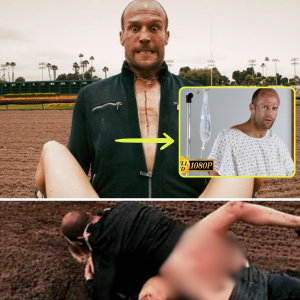Jason Statham, the iconic action star known for his roles in high-octane films, found himself in a real-life drama that tested his patience and resolve. While filming on location in a city with a significant homeless population, he became acutely aware of the underlying tensions and conflicts that plagued the local slums. Groups of homeless people had formed factions that were increasingly at odds with each other, leading to frequent and violent clashes. The sight of such turmoil deeply disturbed Statham, igniting a fiery anger within him.
Statham, known for his tough-guy persona on screen, was not one to turn a blind eye to injustice. He had always believed in using his platform for good and had a long history of supporting charitable causes. Seeing the misery and strife among the homeless community firsthand was a stark reminder of the challenges these individuals faced daily. The constant bickering and fighting over scarce resources, such as food, shelter, and safety, created an environment of perpetual tension and danger.
Driven by a sense of moral duty, Statham decided to take action. He began by reaching out to local organizations that worked with the homeless, seeking to understand the root causes of the conflicts. Through conversations with social workers, volunteers, and the homeless individuals themselves, he learned about the lack of resources, the struggles for territory, and the desperation that drove these people to form opposing factions. It was a complex web of issues, exacerbated by the systemic neglect and societal indifference.
Statham’s anger was not directed at the homeless individuals themselves but at the circumstances that forced them into such a dire state. He saw the humanity in their plight and was determined to help them find a way out of the cycle of conflict. Using his influence, he organized a meeting with local government officials, business leaders, and representatives from various non-profits. His goal was to create a collaborative effort to address the immediate needs of the homeless community and to develop long-term solutions.
At the meeting, Statham spoke passionately about the need for compassion, understanding, and concrete action. He called for the establishment of more shelters, the provision of mental health services, and job training programs to help the homeless regain their footing in society. He also emphasized the importance of mediation and conflict resolution initiatives to help reduce the violence and animosity between the opposing groups.
Statham’s involvement brought significant attention to the issue. Media outlets covered his efforts extensively, shining a spotlight on the plight of the homeless in the city. Public awareness grew, and donations poured in from his fans and other concerned citizens. This influx of support enabled the local organizations to expand their services and reach more people in need.
One of the most impactful initiatives that emerged from Statham’s efforts was a series of workshops focused on conflict resolution and community building. These workshops, facilitated by trained mediators, provided a safe space for the homeless individuals to voice their grievances, understand each other’s perspectives, and work towards peaceful coexistence. Over time, these sessions helped to reduce the number of violent incidents and fostered a sense of solidarity among the previously warring factions.
Statham also made regular visits to the shelters and community centers, spending time with the homeless individuals and listening to their stories. His presence was a source of inspiration and hope, showing them that someone cared about their well-being and was committed to making a difference. He encouraged them to take advantage of the resources available and to support each other in their journey towards a better life.
Through his persistent efforts, Statham helped to bring about meaningful change in the slums. While the challenges were far from over, the initial steps taken towards resolving the conflicts and improving the living conditions of the homeless community were promising. His anger had been channeled into a powerful force for good, demonstrating that even in the face of overwhelming adversity, compassion and determination could pave the way for a brighter future.
In the end, Jason Statham’s intervention was a testament to the impact that one individual could have when driven by a sense of justice and empathy. His actions not only alleviated the immediate suffering of many homeless individuals but also set in motion a broader movement towards addressing the systemic issues that contributed to their plight. For Statham, it was a deeply fulfilling experience, reminding him of the profound difference that could be made when one chose to stand up and fight for the vulnerable and marginalized members of society.





